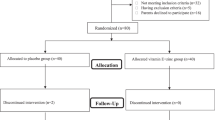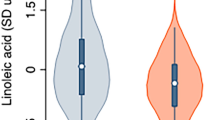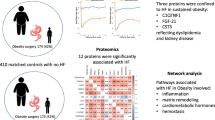Abstract
Background/objectives:
Randomised controlled trials (RCTs) evaluating the effect of fish oil supplementation on postoperative atrial fibrillation (POAF) following cardiac surgery have produced mixed results. In this study, we examined relationships between levels of red blood cell (RBC) n-3 long-chain polyunsaturated fatty acids (LC-PUFAs) and the incidence of POAF.
Subjects/methods:
We used combined data (n=355) from RCTs conducted in Australia and Iceland. The primary end point was defined as POAF lasting >10 min in the first 6 days following surgery. The odds ratios (ORs) for POAF were compared between quintiles of preoperative RBC n-3 LC-PUFA levels by multivariable logistic regression.
Results:
Subjects with RBC docosahexaenoic acid (DHA) in the fourth quintile, comprising a RBC DHA range of 7.0–7.9%, had the lowest incidence of POAF. Subjects in the lowest and highest quintiles had significantly higher risk of developing POAF compared with those in the fourth quintile (OR=2.36: 95% CI; 1.07–5.24 and OR=2.45: 95% CI; 1.16–5.17, respectively). There was no association between RBC eicosapentaenoic acid levels and POAF incidence.
Conclusions:
The results suggest a ‘U-shaped’ relationship between RBC DHA levels and POAF incidence. The possibility of increased risk of POAF at high levels of DHA suggests an upper limit for n-3 LC-PUFAs in certain conditions.
This is a preview of subscription content, access via your institution
Access options
Subscribe to this journal
Receive 12 print issues and online access
$259.00 per year
only $21.58 per issue
Buy this article
- Purchase on Springer Link
- Instant access to full article PDF
Prices may be subject to local taxes which are calculated during checkout
Similar content being viewed by others
References
Hill LL, Kattapuram M, Hogue CW Jr . Management of atrial fibrillation after cardiac surgery—Part I: Pathophysiology and risks. J Cardiothorac Vasc Anesth 2002; 16: 483–494.
Siebert J, Anisimowicz L, Lango R, Rogowski J, Pawlaczyk R, Brzezinski M et al. Atrial fibrillation after coronary artery bypass grafting: does the type of procedure influence the early postoperative incidence? Eur J Cardiothorac Surg 2001; 19: 455–459.
Villareal RP, Hariharan R, Liu BC, Kar B, Lee VV, Elayda M et al. Postoperative atrial fibrillation and mortality after coronary artery bypass surgery. J Am Coll Cardiol 2004; 43: 742–748.
Calò L, Bianconi L, Colivicchi F, Lamberti F, Loricchio ML, de Ruvo E et al. n-3 Fatty acids for the prevention of atrial fibrillation after coronary artery bypass surgery: a randomized, controlled trial. J Am Coll Cardiol 2005; 45: 1723–1728.
Heidarsdottir R, Arnar DO, Skuladottir GV, Torfason B, Edvardsson V, Gottskalksson G et al. Does treatment with n-3 polyunsaturated fatty acids prevent atrial fibrillation after open heart surgery? Europace 2010; 12: 356–363.
Saravanan P, Bridgewater B, West AL, O'Neill SC, Calder PC, Davidson NC . Omega-3 fatty acid supplementation does not reduce risk of atrial fibrillation following coronary artery bypass surgery: a randomized, double blind, placebo controlled clinical trial. Circ Arrhythm Electrophysiol 2010; 3: 46–53.
Farquharson AL, Metcalf RG, Sanders P, Stuklis R, Edwards JRM, Gibson RA et al. Effect of dietary fish oil on atrial fibrillation after cardiac surgery. Am J Cardiol 2011; 108: 851–856.
Sorice M, Tritto FP, Sordelli C, Gregorio R, Piazza L . N-3 polyunsaturated fatty acids reduces post-operative atrial fibrillation incidence in patients undergoing ‘on-pump’ coronary artery bypass graft surgery. Monaldi Arch Chest Dis 2011; 76: 93–98.
Sandesara CM, Chung MK, Van Wagoner DR, Barringer TA, Allen K, Ismail HM et al. A randomized, placebo-controlled trial of omega-3 fatty acids for inhibition of supraventricular arrhythmias after cardiac surgery: the FISH trial. J Am Heart Assoc 2012; 1: e000547.
Mozaffarian D, Marchioli R, Macchia A, Silletta MG, Ferrazzi P, Gardner TJ et al. Fish oil and postoperative atrial fibrillation: the omega-3 fatty acids for prevention of post-operative atrial fibrillation (OPERA) randomized trial. JAMA 2012; 308: 2001–2011.
Harris WS, Pottala JV, Lacey SM, Vasan RS, Larson MG, Robins SJ . Clinical correlates and heritability of erythrocyte eicosapentaenoic and docosahexaenoic acid content in the Framingham Heart Study. Atherosclerosis 2012; 225: 425–431.
Metcalf RG, James MJ, Gibson RA, Edwards JRM, Stubberfield J, Stuklis R et al. Effects of fish oil supplementation on myocardial fatty acids in humans. Am J Clin Nutr 2007; 85: 1222–1228.
Skuladottir GV, Heidarsdottir R, Arnar DO, Torfason B, Edvardsson V, Gottskalksson G et al. Plasma n-3 and n-6 fatty acids and the incidence of atrial fibrillation following coronary artery bypass graft surgery. Eur J Clin Invest 2011; 41: 995–1003.
James MJ, Ursin VM, Cleland LG . Metabolism of stearidonic acid in human subjects: comparison with the metabolism of other n-3 fatty acids. Am J Clin Nutr 2003; 77: 1140–1145.
Costanzo S, di Niro V, Di Castelnuovo A, Gianfagna F, Donati MB, de Gaetano G et al. Prevention of postoperative atrial fibrillation in open heart surgery patients by preoperative supplementation of n-3 polyunsaturated fatty acids: an updated meta-analysis. J Thorac Cardiovasc Surg 2013; 146: 906–911.
Mozaffarian D, Wu JH, de Oliveira Otto MC, Sandesara CM, Metcalf RG, Latini R et al. Fish oil and post-operative atrial fibrillation—a meta-analysis of randomized controlled trials. J Am Coll Cardiol 2013; 61: 2194–2196.
Mozaffarian D, Psaty BM, Rimm EB, Lemaitre RN, Burke GL, Lyles MF et al. Fish intake and risk of incident atrial fibrillation. Circulation 2004; 110: 368–373.
Virtanen JK, Mursu J, Voutilainen S, Tuomainen T-P . Serum long-chain n-3 polyunsaturated fatty acids and risk of hospital diagnosis of atrial fibrillation in men. Circulation 2009; 120: 2315–2321.
Wu JHY, Lemaitre RN, King IB, Song X, Sacks FM, Rimm EB et al. Association of plasma phospholipid long-chain omega-3 fatty acids with incident atrial fibrillation in older adults: the cardiovascular health study. Circulation 2012; 125: 1084–1093.
Liu T, Korantzopoulos P, Shehata M, Li G, Wang X, Kaul S . Prevention of atrial fibrillation with omega-3 fatty acids: a meta-analysis of randomised clinical trials. Heart 2011; 97: 1034–1040.
Tomita T, Hata T, Takeuchi T, Oguchi Y, Okada A, Aizawa K et al. High concentrations of omega-3 fatty acids are associated with the development of atrial fibrillation in the Japanese population. Heart Vessels 2012; 28: 497–504.
Shen J, Johnson VM, Sullivan LM, Jacques PF, Magnani JW, Lubitz SA et al. Dietary factors and incident atrial fibrillation: the Framingham heart study. Am J Clin Nutr 2011; 93: 261–266.
Kowey PR, Reiffel JA, Ellenbogen KA, Naccarelli GV, Pratt CM . Efficacy and safety of prescription omega-3 fatty acids for the prevention of recurrent symptomatic atrial fibrillation: a randomized controlled trial. JAMA 2010; 304: 2363–2372.
Menezes AR, Lavie CJ, DiNicolantonio JJ, O'Keefe J, Morin DP, Khatib S et al. Atrial fibrillation in the 21st century: a current understanding of risk factors and primary prevention strategies. Mayo Clin Proc 2013; 88: 394–409.
Rix TA, Joensen AM, Lundbye-Christensen S, Riahi S, Schmidt EB, Overvad K . Moderate consumption of marine n-3 fatty acids is associated with a lower risk of atrial fibrillation—a cohort study (Abstract). Europace 2013; 15 (S2), S84.
Kumar S, Sutherland F, Lee JM, Robinson T, Heck PM, Wong MC et al. Effects of high dose intravenous fish oil on human atrial electrophysiology: implications for possible anti- and pro-arrhythmic mechanisms in atrial fibrillation. Int J Cardiol 2013; 168: 2754–2760.
Harris WS, von Schacky C . The Omega-3 Index: a new risk factor for death from coronary heart disease? Prev Med 2004; 39: 212–220.
Gawrisch K, Soubias O, Mihailescu M . Insights from biophysical studies on the role of polyunsaturated fatty acids for function of G-protein coupled membrane receptors. Prostaglandins Leukot Essent Fatty Acids 2008; 79: 131–134.
Turner N, Else P, Hulbert AJ . Docosahexaenoic acid (DHA) content of membranes determines molecular activity of the sodium pump: implications for disease states and metabolism. Naturwissenschaften 2003; 90: 521–523.
Leaf A, Kang JX, Xiao Y-F, Billman GE . Clinical prevention of sudden cardiac death by n-3 polyunsaturated fatty acids and mechanism of prevention of arrhythmias by n-3 fish oils. Circulation 2003; 107: 2646–2652.
De Caterina R . n–3 Fatty acids in cardiovascular disease. N Engl J Med 2011; 364: 2439–2450.
Proudman SM, Cleland LG, James MJ . Dietary omega-3 fats for treatment of inflammatory joint disease: efficacy and utility. Rheum Dis Clin North Am 2008; 34: 469–479.
von Schacky C . Omega-3 fatty acids: anti-arrhythmic, pro-arrhythmic, or both? Front Physiol 2012; 3: 88 doi:10.3389/fphys.2012.00088.
Acknowledgements
This work was supported by grant 399333 from the National Health and Medical Research Council of Australia, Canberra, Australia, and by grants from the Icelandic Centre for Research (RANNIS, grant no. 080411021), the University of Iceland Research Fund and the Landspitali – The National University Hospital of Iceland Research Fund. Dr Sanders is supported by the National Heart Foundation of Australia, Melbourne, Australia. Dr Gibson is supported by the National Health and Medical Research Council of Australia, Canberra, Australia.
Author information
Authors and Affiliations
Corresponding author
Ethics declarations
Competing interests
The authors declare no conflict of interest.
Additional information
Supplementary Information accompanies this paper on European Journal of Clinical Nutrition website
Supplementary information
Rights and permissions
About this article
Cite this article
Metcalf, R., Skuladottir, G., Indridason, O. et al. U-shaped relationship between tissue docosahexaenoic acid and atrial fibrillation following cardiac surgery. Eur J Clin Nutr 68, 114–118 (2014). https://doi.org/10.1038/ejcn.2013.215
Received:
Revised:
Accepted:
Published:
Issue Date:
DOI: https://doi.org/10.1038/ejcn.2013.215
Keywords
This article is cited by
-
Omega-3 fatty acids in heart disease—why accurately measured levels matter
Netherlands Heart Journal (2023)



